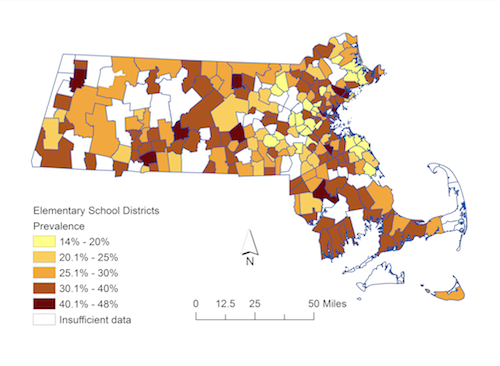 |
|
| Wenjun Li, PhD |
A new analysis of childhood obesity rates across public school districts in Massachusetts shows wide disparities, according to a new report from UMass Medical School and the Massachusetts Department of Public Health (DPH).
“This is the first in-depth analysis by grade, gender, age group and community income,” said UMass Medical School biostatistician and lead author Wenjun Li, PhD. “A previous analysis looked at entire communities. In this study, we looked at individual school districts. The overall changes we observed were primarily due to improvements in public schools in high-income districts. We did not see much change in low-income districts.”
Published online Aug. 13 by the American Journal of Public Health, the new report includes more detailed information about which children in Massachusetts public school districts are overweight than in the 2013 findings that childhood obesity was on the decline statewide.
Massachusetts public schools are required to weigh students and measure their heights in grades 1, 4, 7 and 10 to capture data which will help the DPH, school officials and community health agencies understand local obesity trends and develop appropriate solutions. The original report analyzed data collected from 2009, the first year of the mandate, through 2013. With the addition of 2014 data and more in-depth analysis, the current report provides a more nuanced picture of the prevalence of overweight and obesity over the five-year period.
From 2009 to 2014, obesity prevalence decreased from 34 percent to 31 percent statewide, but district-level obesity rates ranged from a low of 14 percent in Cohasset, to as high as 47.4 percent of students in Everett. When stratified by grade, the decreasing trends were significant only in grades 1 and 4. Although rates in districts with a median annual household income greater than $37,000 improved notably, obesity rates of the poorest remain unchanged. The authors conclude that efforts should be made to address the needs of socioeconomically disadvantaged districts and narrow the disparities in childhood obesity.
 |
|
| Prevalence in Childhood Overweight and Obesity in Massachusetts Public School Districts (2014) |
“Communities with the lowest incomes have the highest burden of childhood obesity,” said Dr. Li, associate professor of medicine in the Division of Preventive and Behavioral Medicine at UMMS. “The challenge is, can we do something to help the public schools with the highest prevalence of obesity achieve as much improvement as has been achieved in high-income schools?”
“The first step to finding solutions is to fully understand the problem,” said Tom Land, director of the Massachusetts Department of Public Health’s Office of Data Management and Outcomes Assessment. “Those of us in public health must continue to work closely with our partners to collect and analyze data in a meaningful way.”
“We know we are successful in some schools, but we can’t explain why,” Li noted. “Our hope is to understand what happened in the public schools that were more successful in bending the childhood obesity curve during those years to guide future interventions for those left behind.”
Further research is also needed to understand why good results decline as kids get older and into higher grades, a trend which indicates there is a need for early intervention to avoid obesity in younger children.
Related links on UMassMedNow:
UMMS scientist reports declining obesity among Mass. students
UMMS study on childhood obesity perception a wake-up call; covered by national media